If only – writing through the spatiality of corporeality
This presentation illuminates a process of writing through corporeality in artistic research, in which the impossibility of writing forms a challenge, in which re-writing and erasure, naming and un-naming produce on each occasion a certain kind of temporality through which something from the lived, sensuous experiences of moving may continue to resonate in the text. If only. The writer, within the disappearance of the known I, is lost in between the spatialities and temporalities of corporeality influenced by a somatic movement method, the Skinner Releasing Technique (SRT). Walking and standing, pausing and waiting, attuning to the lived experiences through the spatiality of corporeality leads one into a void as darkness and strangeness demanding the writer to expose oneself into the act of writing not being totally aware of what the written corporeality writes. Nevertheless, something may resonate, something unheard be called forth, given space to linger. In each artistic study, corporality as processual and relational becomes a spatial-temporal milieu or a passage through which events are channelled that generates a fragmentary and a spiral way of writing, in which language continues searching, meandering through its various rhythms, silences and pauses going beyond discursive logic. What is the sense of this kind of inscription, in which the unnamable and vague yet lived resonance with its temporal intensity in corporeality may blossom and how much to argue for something that is grounded in darkness, ruptures and gaps? What does writing as forgetting, not naming, effacement, loss, violence, being lost or treachery do? Where does this non-personal circular writing approach aimed to nobody lead to, and what about its communicability? The presentation is mainly based on the practice of the Skinner Releasing Technique including theory it contains and writings by Maurice Blanchot.
This text discusses the act of writing, or rather the impossibility of writing in artistic research projects, from the perspective of the artist-researcher and suggests possible conditions for writing to happen. It embraces a yearning or a desire to write, and through fragmentary notions imagines some of the conditions required to perform the kind of writing it aspires to. In contemplating language, writing, and the writer, the role of a somatic movement practice, the Skinner Releasing Technique (SRT), and especially its notion of the spatiality of corporeality, is vital. The photographs of drawings originate from various SRT classes where they were rapidly drafted immediately after the artist-researcher’s experiences of movement, and they may mediate something unsayable about the effort of communicating through spaces and temporalities characterized by gaps, erasures and fractures. Much of what follows is based on the ongoing practice of SRT and draws on Maurice Blanchot’s insights on approaching the realm of writing.
If only one could write
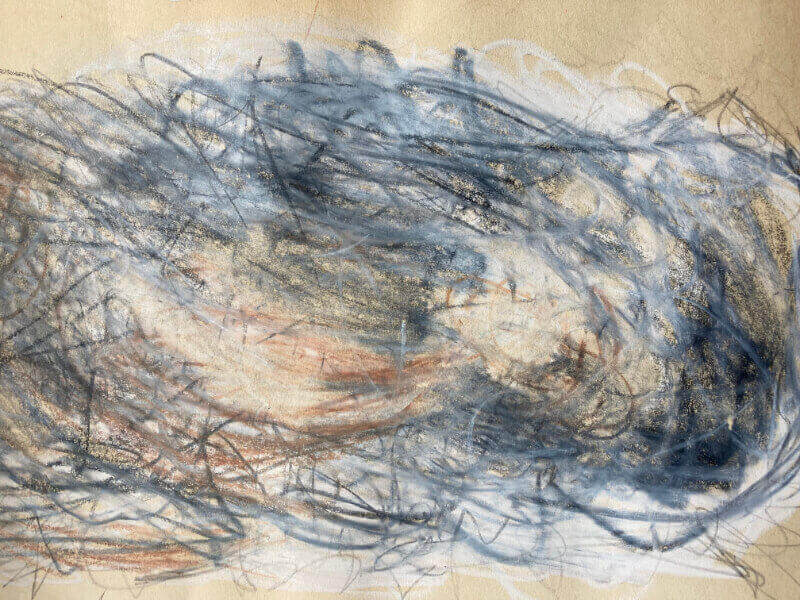
How, by writing, can one get into the folds of the sensate, to the lived experiences that rapidly flee and hide in one’s layers of flesh? It is impossible. Yet, writing as an impossible challenge brings comfort. According to Marguerite Duras:
One must write.
(Duras 2011, 78)
I cannot.
Nobody can.
One must say: I cannot.
And then one writes.
The writer carries the unknown inside him/herself: it is a matter about writing. Either about that or nothing.
First, to admit my failure in writing, since I am only writing about writing, and dwelling on the threshold without entering the aspired realm of writing. However, writing in the presence of lived experiences gained through the Skinner Releasing Technique (SRT), especially that of the spatiality of corporeality, and pondering some of Blanchot’s notions of writing. And to stumble amid these words, lines, and pages ‒ like crossing a desert. How does one start writing about something that is almost nothing that seeks to carry vastness within itself?
If only an immense space would appear in the writing

Each morning I lie on the wood floor and invite my breath to travel throughout my corporeality and by small movements, so called kinesthetic rituals, allow a softening to happen and spaces to be opened in my corporeality. Is there a hope that then something of the spatiality of corporeality will enter writing? Or is it that one is compelled to write by the emergence of spatiality?
If only this page could unfold by the void of writing, as Blanchot (1992, 80) describes it. In the practice of SRT, the spatiality of corporeality is related to the releasing process. Space is invited to disclose itself by verbal instructions which themselves contain window-like spaces in the vertebrae or in the valleys formed by the hips as well as by the physical touch of a partner, a touch that is mostly light, subtle. Moreover, by immersing oneself in images like moss, mist or a rainforest, the contours of one’s corporeality become blurred and porous; spaces move, gather, spread through the corporeal and along the curves of the bones. Could this expansion of space in and around corporeality be transferred into writing so that the intimacy of its signification would be erased or fade making way for new possibilities and thoughts? If only…
In the practice of SRT and of reading and writing, the notion of spatiality blurs the subject, offering no safe or separate site, since corporeality is scattered and continuously unfolding in and through vast spatialities. The multi-directionality of the corporeal is such that each direction has an equal value, and no ups and downs exist; corporeality itself is taken as a site of finite and infinite spaces like caves and caverns. And to experience the dynamic stillness of space, to be “enveloped by stillness” (Skinner 2005) that invites one to halt, to be at one with space around. To halt, to wait without waiting, to linger between activity and passivity as a kind of inaction in that kind of spaciousness. Sometimes that is enough.
Drifting in the sea of language, words; travelling across islands of silences. In the images used in SRT, the sense of spatiality is also created by verbs like floating, skipping, hanging, or landing. Furthermore, the distances described are immense: lying in an enormous hammock over an open field, which is “caught between two very tall trees or from two clouds or even just suspended by itself in space” (Skinner 2005). All this brings airiness, freedom for acting and forgetting the forces of gravity and temporality as the sense of clock-time is distorted by that of spatiality.
Images during SRT classes appear as if out of nowhere and gradually resolve, leaving one in a state of wonderment along with a sense of continuous release and of spaces opening in one’s corporeality. Could that have something in common with a kind of writing which, as describes by Blanchot (1992, 50) “is not destined to leave traces, but to erase, by traces, all traces, to disappear in the fragmentary space of writing, more definitely than one disappears in the tomb”? Something seems to pass quietly into the immensity of space in the calmness of moving, of being awake, aware, and just breathing the moment. To witness oneself moving and, hopefully, writing.
If only one could be nobody
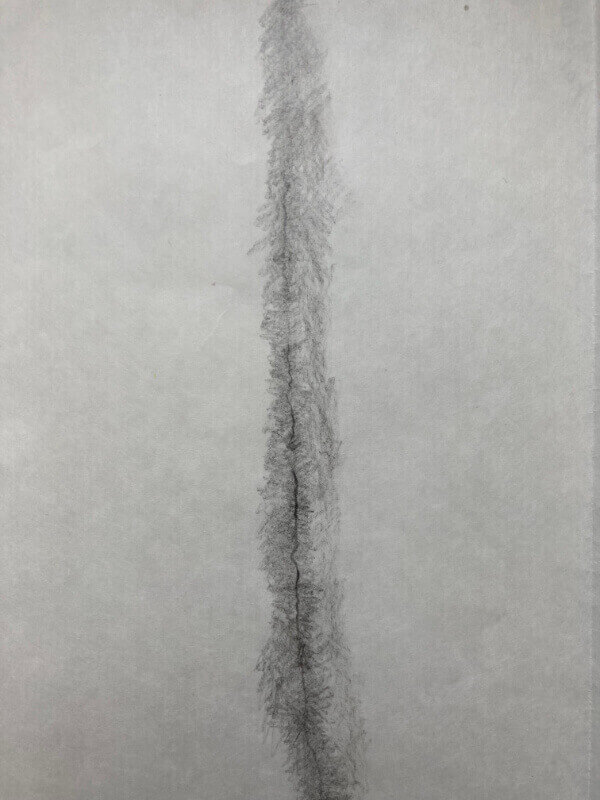
The one-who-writes has travelled in a multitude of landscapes within moving silence, willowy fields, or crystal-clear pools, immersed in and transformed into those images introduced by SRT. Through that process, one has become a passage, through which a possibility exists, if only a faint one of transferring in writing something of the presences that, as they transcend conscious acts, have disappeared without being possessed. If only…
Moving has enabled the known “I” to disappear at least momentarily or even forever, since the “I” is, as Blanchot (1995a, 64) states, “always already lost”. He describes writing as surrendering to the interminable, as “a witness to the unencountered, answerable not only for the void in the subject, but for the subject as a void its disappearance in the imminence of a death” (Blanchot 1995a, 121). The lived notions of porousness, shifting awareness or availability all increase the sense of spatiality, allowing one to detach oneself from one’s characteristics and preferences and become a kind of “empty place where impersonal affirmation emerges” (Blanchot 1982, 55).
One also finds affinity with Blanchot’s notion that “something essential is lacking in anyone who expresses himself“ (Blanchot 1995b, 324). There is a sense of severity in his view that “the writer belongs to a language which no one speaks, which is addressed to no one, which has no center, and which reveals nothing” (Blanchot 1982, 26). If writing appears from nobody and nowhere and disappearing into the void, what kind of resonance or intensity might it generate?
If only one could write without naming
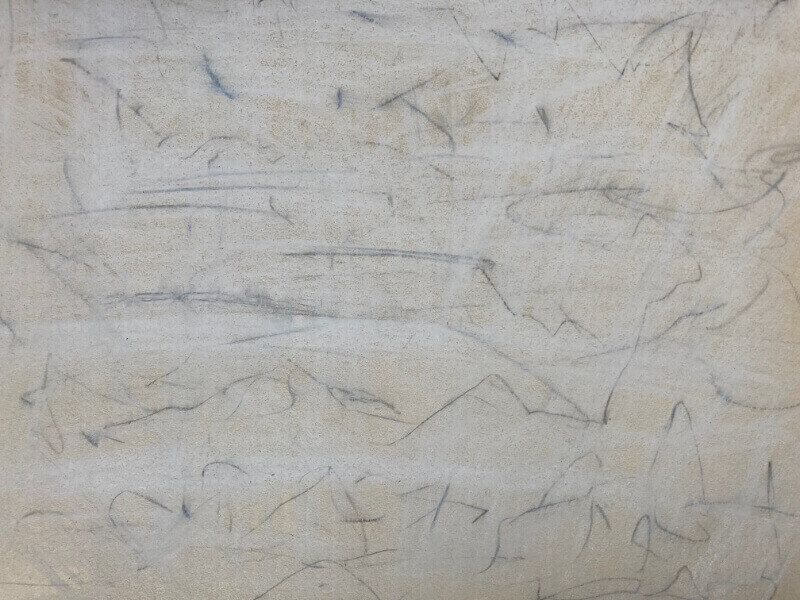
Although the imagery of SRT is lucid and presented in sentences that have been carefully crafted over the decades by Joan Skinner, the founder of the technique, helped by the comments of practitioners, its impact is unpredictable and felt differently by each participant each time. The effects it has had on my moving and writing corporeality are obscure, nameless, yet powerful. While lacking the ability to describe the nature of the lived experience precisely, it turns out to be an intimate cradling, palpating experience that invites me to pause in wonderment about what has happened. While the aim of SRT is not to draw movers into an existential abyss, its vocabulary, which conveys the sense of infinite spaces and darkness beyond signification, may provoke one to strongly question one’s previous notions of language and writing, and lose oneself in words. Disorientation has befallen one.
As literature refuses naming by turning a name into something obscure and without meaning, signification in general appears in the place of the destroyed meaning of the name. The meaning of meaningless appears in the word as an expression of the obscurity of existence, what Blanchot calls “a strange impersonal light” (Blanchot 1995b, 329). Thus “the word acts as not as an ideal force but as an obscure power, as an incantation that coerces things, makes them really present outside themselves” (ibid., 328). In moving according to the instructions of SRT, words have seduced me, taken me into unknown territory, and the moments of falling into an emptiness as darkness have been horrifying; space has unfolded in its immensity with no exit.
If only words would touch
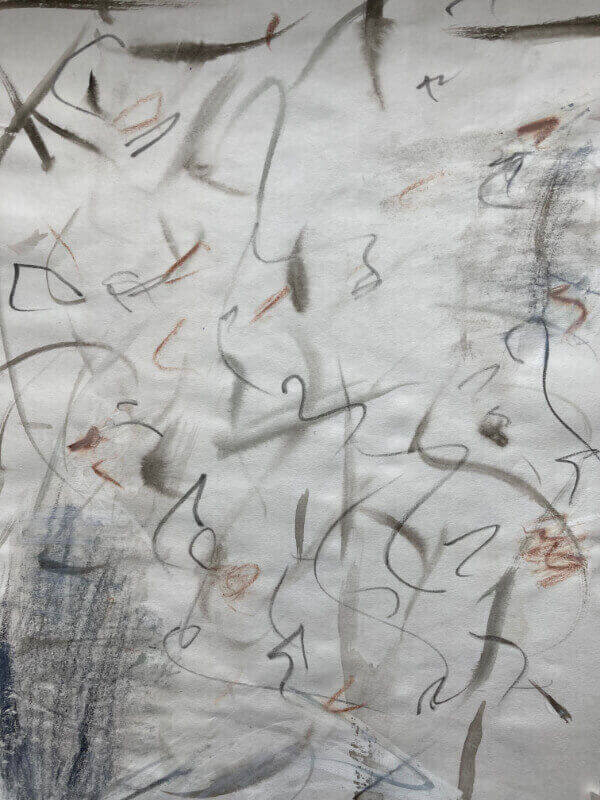
And yet, “[w]hat does a word touch, if not a body?” as Nancy (1993, 190) writes. Could words be as soft as a whisper or a gentle stroking on the surface of the skin, not seductive but leaving space for a reaction? This corporeality unknown to me to me has been touched in diverse ways: light touches with the fingertips, firm ones, tapping, nudging, stroking, brushing, and holding. Their aim is mainly to hint, to offer one ways to be aligned in the world, to be in space and of space. Yet how does one differentiate hinting from manipulation, even if gently done? SRT has molded this corporeality to become a shifting field of countless spatialities where different kinds of touch direct perception. Could something of those embedded touches move into writing, as a reminder of the textuality and materiality in the weight that phenomena generate in (my) artistic research projects?
The vocabulary of SRT has pierced and engraved itself in this, my foreign corporeality. Blanchot (1993, 28) reminds us that writing is like a violent cut, referring to the etymology of the term as a tear, a cutting movement, and how the stylet, which was a tool for writing, was also a tool for making incisions. Yet the cutting movement is also an opening to the world, a spatial act of letting oneself loose, breaking the bond between the word and oneself, as has happened in my practice of SRT. And as language without a subject becomes an experience of loss of the mastery of self (Haase & Large 2001, 3), it is also described as an awareness, as “detachment, questioning, infinite ability to create emptiness and to place itself within loss” (Blanchot 1995b, 42). Simply, the inexplicable touch of words on corporeality.
If only the forgotten, erased and obliterated existed as a transparent layer in the fragments of writing
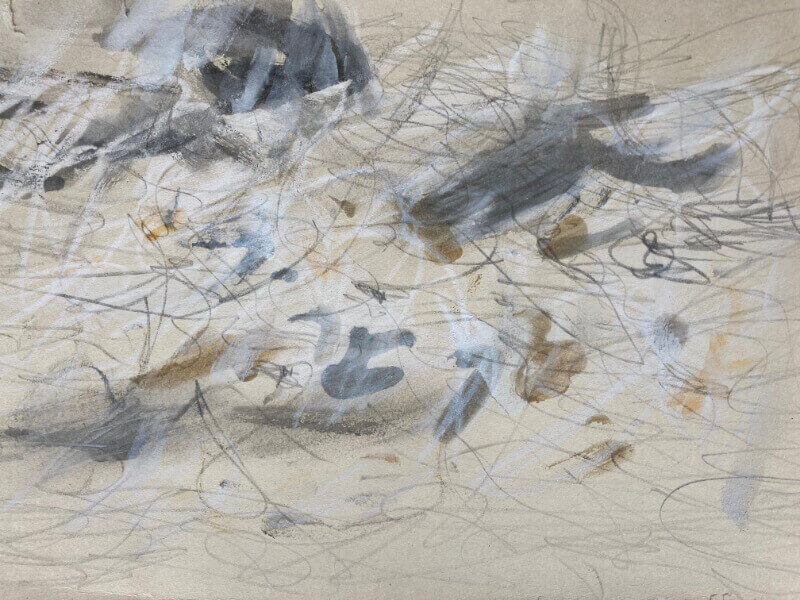
And now, after pausing, hesitating, reiterating and countless efforts at rewriting and erasure, the question remains of how to start to articulate something that is constantly receding, fading into the void, or hiding in the caves of corporeality? I become aware of my tendency to turn to something that dwells in the silent shadows. How to trace through writing, even fragmentary writing, something that appears, leaks, hides itself, springs, reappears, obliterates, and confirms itself, effaces, falls in between the lines, shouts from the silence, forms and deforms itself? In the practice of SRT, sometimes “it” moves the mover, who, connected to it, simply follows it. Is it possible to be both aware and appreciate in writing all that erases itself, slides into the darkness when “it” writes through the writer? If only …
And this-one-who-writes without a name has surrendered to a reality in which only the hunch of moving and writing exists, and the resonance in the bones relating to each artistic research project leads the way to somewhere. Yet even now, too many words, too many arguments expended on something that is grounded in ruptures and gaps. The strangeness embedded in the experience of moving and writing becomes a way of inhaling the obscurity surrounding one. Hesitating, being a bit lost. And the hopeless feeling of not knowing anything when starting to write, to trust only voids and fractures in the spatiality of and around corporeality, since “no certainty can ever speak” and “language can only begin with the void” (Blanchot 1995b, 324). If only this ending were the beginning of writing without an end.
References
Blanchot, Maurice. 1995a. The Writing of the Disaster. Translated by Ann Smock. Originally published in 1980. Lincoln: University of Nebraska Press.
Blanchot, Maurice. 1995b. “Literature and the Right to Death.” In Maurice Blanchot, The work of Fire. Translated by Lynda Davis. Originally published in 1981. Stanford, California: Stanford University Press, 300–344.
Blanchot, Maurice. 1992. The Step Not Beyond. Translated by Lycette Nelson. Originally published in 1973. Albany, NY: State University of New York Press.
Blanchot, Maurice. 1982. The Space of Literature. Translated by Ann Smock. Originally published in 1955. Lincoln, US: University of Nebraska Press.
Haase, Ullrich & Large, William. 2001. Maurice Blanchot. London and New York: Routledge.
Duras, Marguerite. 2011. Writing. Translated by Mark Polizzotti. Originally published in 1993. Minneapolis & London: University of Minnesota Press.
Nancy, Jean-Luc. 1993. The Birth to Presence. Translated by Brian Holmes & others. Stanford, California: Stanford University Press.
Skinner, Joan. 2005. Introductory Pedagogy. Seattle: Unpublished.
Contributor
Kirsi Heimonen
Dr Kirsi Heimonen is a university researcher at the Centre for Artistic Research of the University of the Arts Helsinki. She is an artist-researcher with a background in dance, choreography, somatic movement methods and experimental writing. Her recent interests in artistic research have focused on silence and, in a multidisciplinary research project, Engraved in the Body, on the way in which mental hospital inpatients’ written memories are interwoven with the environment.